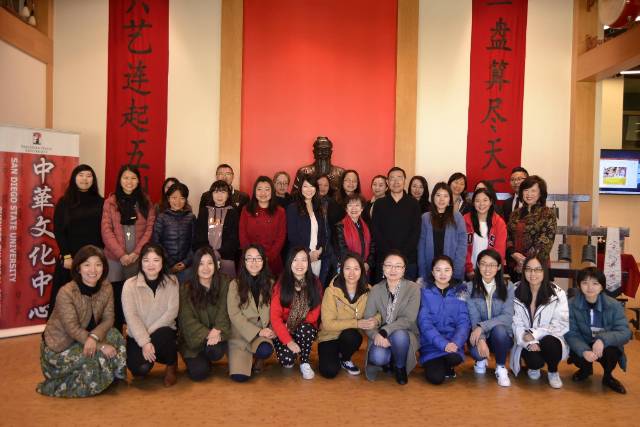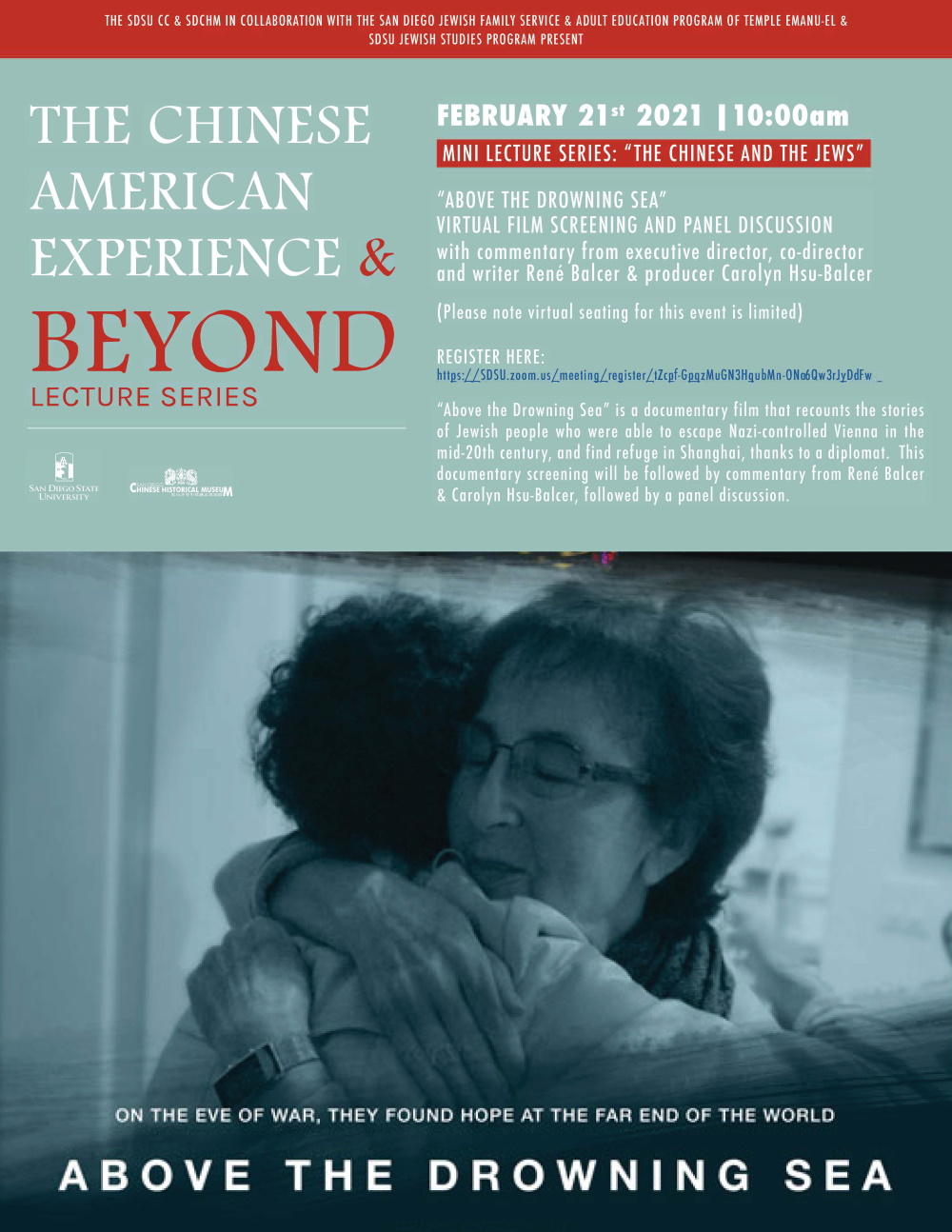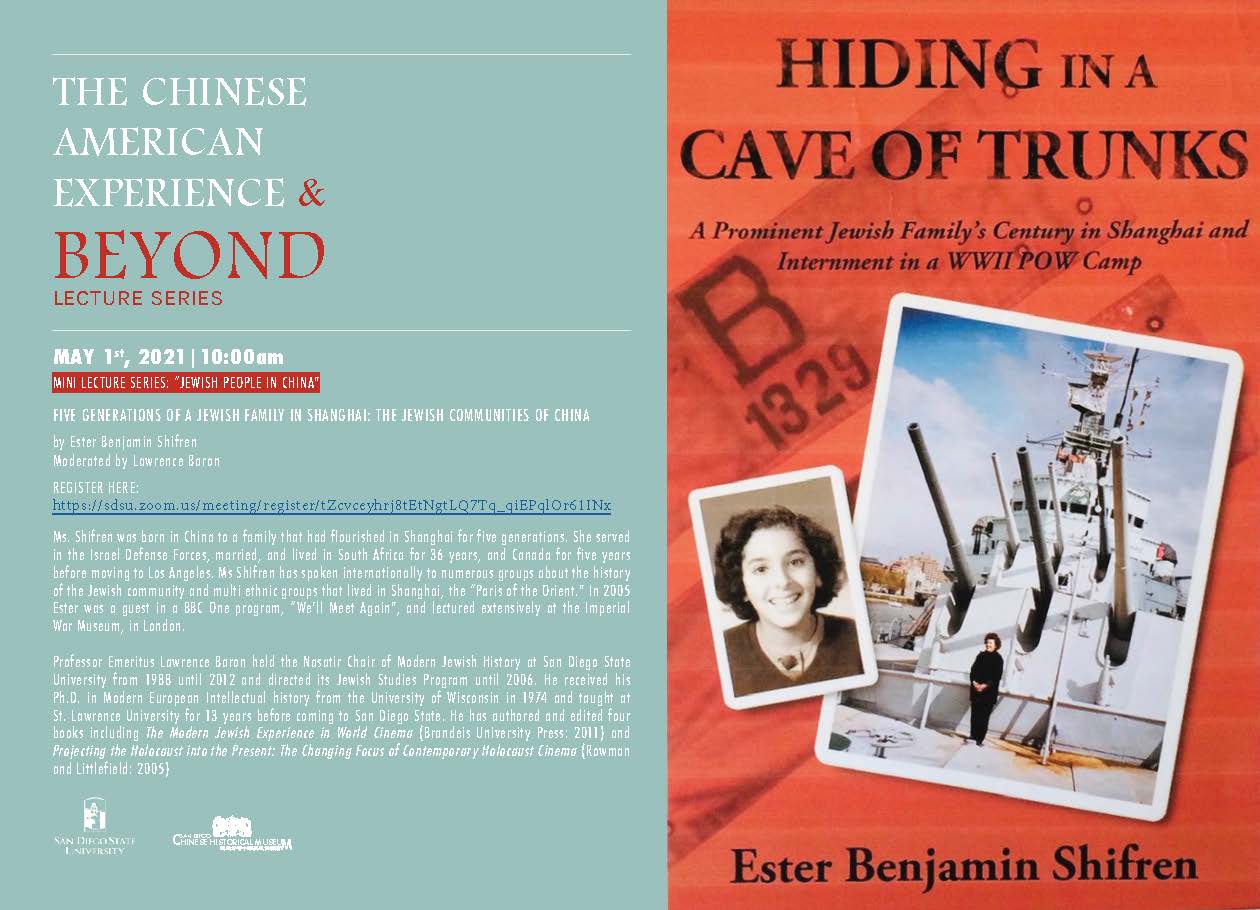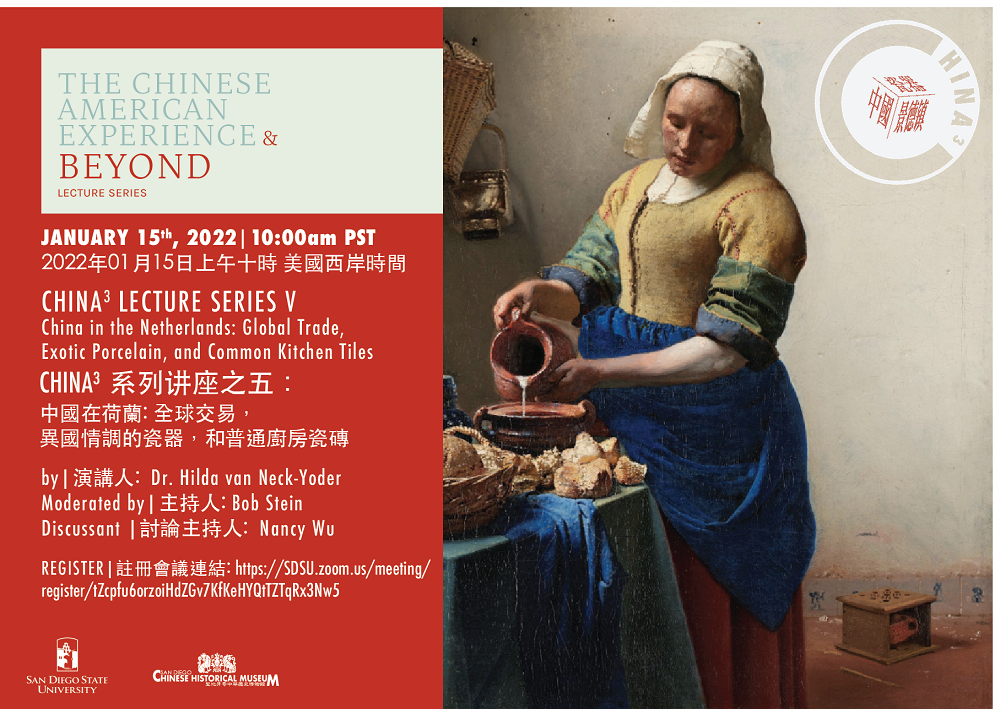Chinese Culture Workshop
CCC hosts Chinese culture workshops and forums several times a year. The workshops address different educational and cultural issues.

Once a month on Saturday
Speaker :
Michael Yee and
Amie Lee Garaprich
This is a virtual tour to explore the historical district of Chinese, Japanese and Filipino communities between the Gaslamp district and the Marina area. Many historical buildings that now serve as restaurants or public places all have stories behind them. Listen to these stories as you look at the buildings.
Speaker :
Russell Low
Three Coins recreates the world of Tong Yan Gai or Chinatown before the turn of the century. It is a world where old traditions and family values are set against the unwelcoming attitudes of the American West. It is told by the great grandson of a railroad worker and a child slave.

Speaker :
Catherine Jones
Jade was more valuable than gold in Chinese tradition. As far back as 5000 years ago, jade or nephrite was buried in tombs. Later, different colors of jade stones were carved for any decorative or symbolic purposes. Among the SDCHM permanent collection, the most astounding item is the full-scale jade suit.
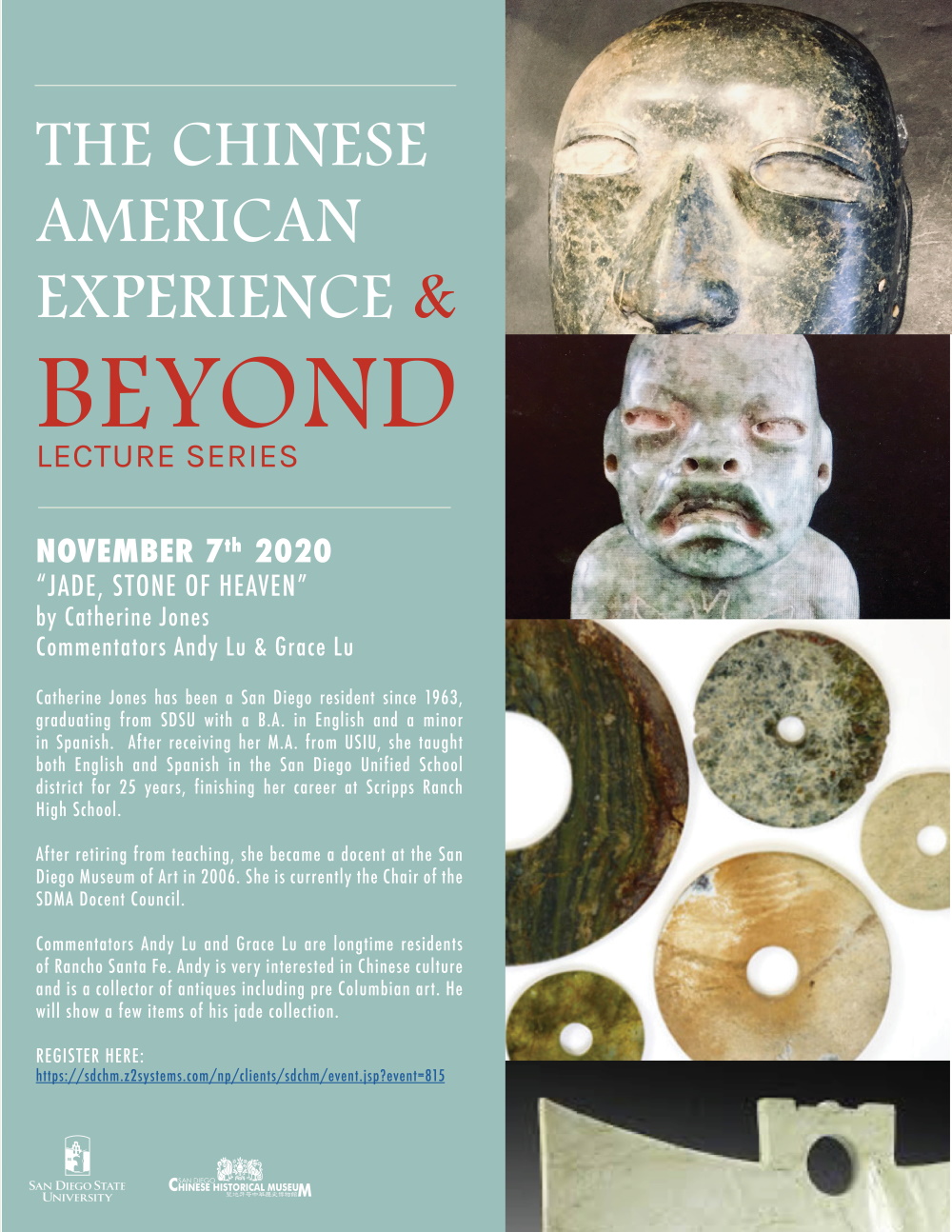
Speaker :
Elaine Pierce
Creating the illusion of three dimensions on a two-dimensional wall has been a fantasy to many. This lecture will cover the marvels in art and architecture that Missionary artist Lang Shining created for the Qianlong Emperor. It was the fusion of the East meets the West.

Speaker :
余春明
中國與西方的貿易往來有著數千年的漫長歲月,在交通工具匱乏的古代,人們為了尋求商業盈利的機會,不辭勞苦,甘冒生命危險與商旅隊伍一起穿過草原沙漠,騎著馬或駱駝、更或是步行,歷經數月、數年之久。商品承載的文化元素在漫長的歲月中,隨著局限的交通工具和沿途惡劣的環境,互相滲透。中國瓷器、絲綢、雕刻中的很多紋樣都來自西方,西方工藝品中也有許多來自中國,流動的工匠們也在異國他鄉用故土的紋飾豐富著他國的文化。
然而,在16-19世紀展開的中外海上貿易與延續了數千年的陸地貿易不同,由大型帆船裝載成噸的商品從中國通向歐美各國,大量的中國商品在西方流通,形成了一股“中國風”——一種由貿易帶來的文化時尚風潮。
中國獨有的瓷器是一種十分特殊的日用品,由於上面畫著各種繪畫而成為文化的載體,瓷器的經久耐用也使這種來自中國的文化影響深遠,以至數百年後的今天,中國明代和清代的瓷器依然在市場上流通,並成為那一段中外貿易史的見證。
這個講座主要是從不同時代、不同貿易國出發,考慮其政治、文化和習俗的不同而影響到中外貿易瓷的紋飾、器型,也就是從紋飾產生的緣由來闡述明清外銷瓷,從貿易主體的角度談瓷器紋飾,這個角度有點意思。
Speaker :
Ray Menegus
Lacquer was used to color, beautify, and protect screens, furniture, sculpture, bowls, etc. It could be carved, incised and inlaid. Mr. Menegus’ personal experience will show you how hard this technique is. You’d appreciate so much more of our collection when you understand the labor and technique of this ancient art form that originated in China.
Speaker : Allie Arnell
In the Qing Dynasty, the vogue for porcelain in Europe would reach its height during the first half of the 18th century. This presentation will show the gorgeous colors such as café au lait, pale yellow, brilliant turquoise, apple green, purple or eggplant, etc. There were over 40 colors in the porcelain during the Qing Dynasty.
Speaker :
Sherry Reeds
Cloisonné is a decorative art form practiced since 1300 BCE. Traditionally, wires are used to divide colors on a metal substrate and to create designs and then filled with fused glass or enamel coloring. But the variations and styles are endless as you learn from this presentation and explore the SDCHM collection in this art form.
"Above the Drowning Sea" is a documentary film that recounts the stories of Jewish people who were able to escape Nazi-controlled Vienna in the mid-20th century, and find refuge in Shanghai, thanks to a diplomat. This documentary screening will ve followed by commentary from Rene Balcer & Carolyn Hsu-Balce, followed by panel discussion.
Registration link :
https://sdsu.zoom.us/meeting/register/tZcpf-GpqzMuGN3HqubMn-ONa6Qw3rJyDdFw
Speaker : David Seid and Joh LeeWong
To be bilingual as a Chinese American was and is a big advantage. Early Chinese immigrants learned English from the church. As their children are born, they want the children to learn Chinese. Mr. LeeWong will trace back how the Chinese Language School started and how it was when he was growing up, and how it is today.
Speaker :
Betty Carr
On April 3, we will be joined by Betty Carr, who will speak about Tang dynasty ceramics. Her talk will cover this era's many different innovations, including Sancai (a lead-glazed tri-colored earthenware), underglaze painting, and the development of true porcelain. She will explain why Tang Dynasty achievements in craft and the large export business that flourished during this time were crucial to bringing Chinese ceramics to the forefront of the world stage.
Speaker :
Dr. William Tong
San Diego State University Chinese Cultural Center and the San Diego Chinese Historical Museum are proud to present a special series on the history of Chinese Americans at San Diego State University. This inaugural talk will be presented by Dr. William Tong, who will discuss new laser-based methods for archaeology and cultural heritage applications in China and Europe. Dr. Barry Chung, Dean of the SDSU School of Education, will moderate this lecture.
Speaker :
Ester Shifren
China-born Ester Benjamin Shifren is the descendent of five generations of British Jewish nationals who lived in Shanghai for more than one century. She and her family were interned for three years by the Japanese during World War II. She has lectured extensively internationally about her life experiences. This promises to be a fascinating presentation about her life.
Speaker :
Robert Stein
Early San Diego Chinatown was centered around the Third Avenue and J Street. When old buildings were removed to build new ones, such as the two Harbor Club Towers and the CCBA Senior Apartment Building, artifacts were collected. These items from the prior Chinese American residents tell the stories of their life, including mining tourmaline for the Qing dynasty Dowager Cixi.
Speaker :
David Miles
Chinese landscape paintings have Southern School and Northern School. But what is the difference? How can we tell them apart? This lecture will show examples of paintings from major painters, and we shall decide who belongs to what school.
Speaker :
Phillip Bloom
Words are everywhere in The Huntington’s Chinese Garden. Names adorn rocks and buildings; poetic couplets frame entryways and vistas. Since 2007 The Huntington has commissioned more than thirty contemporary artists to create the original works of calligraphy. This talk will suggest four foundational perspective for contemplating calligraphy in a garden.
Speaker :
Andrew Lu
Chinese tea culture first appeared more than 4000 years ago. It became popular internationally through trade during the Tang Dynasty in the 7th to 8th century. After hundreds of years of tea culture development, people not only care about the quality of different types of tea, but also about sophisticated tea wares. In this episode, we will introduce to you how Chinese tea culture influenced other country’s tea drinking habits and also show you a few beautiful and unique Qing Dynasty teapots circa 17th century from Andrew Lu’s personal collection. You will learn about the differences between green tea, black tea and scented tea as well as the health benefit of using Yixing clay (Zisha) teapots to properly prepare tea.
Speaker :
Leslie Li
This presentation will address the current rise of anti-Asian sentiment in the United States using the documentary The Kim Loo Sisters as a prism to shed light on the critical issues of race, immigration, ethnicity, and cultural identity. The "Kimmies" were a Chinese American jazz vocal quartet popular in the 1930s and '40s and the first Asian American act to star in Broadway revues.
Speaker :
Marina Cunningham
In 1957, the last of the Russian Jews that had numbered about 20,000 at the end of the Second World War left China heading west to Australia, Canada, Israel, South America and Russia. Among them was the Shlau family: David and Bela Rogovina Shlau, with their children, Jackie (16) Alan (14) and Marina (12). They and several families had been waiting for an exit visa. After Singapore’s Chief Minister, the Sephardic Jew David Marshall met Zhou En-lai, Chairman, Chinese Communist Party, were the visas granted in 1956.
In this talk, Marina will describe life in China in the 1950’s: the schools, remaining and departed friends, gatherings at home, the Jewish and Soviet clubs, standing in line for food, participating in Sino Soviet celebrations, clandestinely listening to forbidden radio news; all under the cloud of worrying about what the future would bring.
Speaker :
Dr. Chris Mi,
Dr. Ping Lu, and
Dr. Samuel Shen
This panel features three Chinese-American scholars from San Diego State University. Each of them has served, or is currently serving, as a department chair at SDSU. They will be presenting select research contributions in their respective professions; additionally, they will discuss their personal experiences working as minorities in U.S. academia. Collectively, they represent the many Chinese American scholars who are working in the U.S. higher education and making extraordinary contributions to our country and the world.
Speaker :
Li-Rong Lilly Cheng
China³ = Changnan x china (porcelain) x China (culture/state)
China³ is a special lecture series hosted by the San Diego Chinese Historical Museum in collaboration with the San Diego State University Chinese Cultural Center. Lectures in this series will consider factors that contributed to the unique role played by Jingdezhen (formerly known as “Changnan”) in the production of a pre-modern global commodity, and how trade of this particular commodity (export porcelain) facilitated forms of cross-cultural exchange that were distinct from the cycles of colonialism and conquest that would characterize relationships between European cultures and the rest of the planet up until to the mid-twentieth century.
The first lecture in the series will set a foundation for the concept, exploring early histories of ceramics production and trade in China. Please join us on September 4th to learn more!
Speaker :
Brocade Wu
Founded in 1973, OCA–Asian Pacific American Advocates is a 501(c)(3) national non-profit, membership-driven organization based in Washington, D.C. with over 50 chapters and affiliates around the country. Touching hundreds of thousands of AAPIs each year, OCA works with its organizational partners, members, chapters, and supporters to empower the next generation of leaders. This presentation, which will be provided by members of the OCA San Diego Chapter, will outline the history of the organization in its 50 years of operation.
Speaker :
Doris Bittar
China³ = Changnan x china (porcelain) x China (culture/state)
China³ is a special lecture series hosted by the San Diego Chinese Historical Museum in collaboration with the San Diego State University Chinese Cultural Center. Lectures in this series will consider factors that contributed to the unique role played by Jingdezhen (formerly known as “Changnan”) in the production of a pre-modern global commodity, and how trade of this particular commodity (export porcelain) facilitated forms of cross-cultural exchange that were distinct from the cycles of colonialism and conquest that would characterize relationships between European cultures and the rest of the planet up until to the mid-twentieth century.
The second lecture in the series will build on the foundation set by the first, exploring cross-cultural exchange through trade and collecting, from Qing dynasty through its fall and the emergence of the Republic. Please join us on September 4th to learn more!
Speaker :
Dr. Virginia Loh-Hagan
Dr. Virginia Loh-Hagan, Faculty Director of the SDSU Asian Pacific Islander Desi American (APIDA) Resource Center and children's book author, will share her research and knowledge about the paper son/daughter experience at Angel Island. She will also discuss the challenges of teaching about the paper son experience and the connections to today's political landscape.
Speaker :
Li-Rong Lilly Cheng
China³ = Changnan x china (porcelain) x China (culture/state)
China³ is a special lecture series hosted by the San Diego Chinese Historical Museum in collaboration with the San Diego State University Chinese Cultural Center. Lectures in this series will consider factors that contributed to the unique role played by Jingdezhen (formerly known as “Changnan”) in the production of a pre-modern global commodity, and how trade of this particular commodity (export porcelain) facilitated forms of cross-cultural exchange that were distinct from the cycles of colonialism and conquest that would characterize relationships between European cultures and the rest of the planet up until to the mid-twentieth century.
Speaker :
M.G. Crisci and
Dr. Cheng Ken Chi
Ma Sicong is one of China's most notable musical geniuses. He composed 57 symphonies and concertos and performed hundreds of sold-out concerts around the globe.
Initially, Chairman Mao Zedong declared the patriotic, dignified Ma "a national treasure" and nicknamed him The King of Violins. But with the advent of the Cultural Revolution, Ma's status plummeted—his music became verboten, family members were murdered, and he was publicly humiliated and physically abused. In 1967, Ma fled his homeland for America. Twenty years later, Ma died of heart complications at the age of 76.
For decades, Ma's bittersweet life facts have been buried in the pages of Chinese history by the CPC. Today's lecture offers attendees a glimpse at Ma's never-before-told story. As such, it includes rare photos, documents, musical excerpts, and inciteful comments from Ma's last remaining family member, Dr. Cheng Ken Chi.
Speaker :
Jamie Kwan
The Cultural Revolution (1966-1976) was a movement that drastically altered the production of the arts in China. Focusing on ceramics produced at Jingdezhen, this lecture explores the political context, different modes of production and fascinating imagery of the period.

Speaker :
Hilda Neck-Yoder
Exotic luxury objects, especially blue and white porcelain made in Jingdezhen during the Ming Wanli reign were the most desirable items in the Netherlands. They are called “Kraak” porcelain which influenced 17th century Dutch art and culture profoundly. This talk will demonstrate how Chinese porcelains were painted by famous artists.
Speaker :
Dr. Robin Yuan
Exotic luxury objects, especially blue and white porcelain made in Jingdezhen during the Ming Wanli reign were the most desirable items in the Netherlands. They are called “Kraak” porcelain which influenced 17th century Dutch art and culture profoundly. This talk will demonstrate how Chinese porcelains were painted by famous artists.
Speaker :
Steven Less and Hannah-Lea Wasserfuhr
Born in Berlin, John Hans Less (1923 – 2011) fled as a 16-year-old together with his family to Shanghai in September 1940 to escape the Nazis. His uprooting and struggle to survive the precarious conditions he encountered as a stateless refugee, including confinement by the Japanese to the Hongkew Ghetto, deeply affected both his life and art. Notwithstanding the contribution he was able to make from his merger earnings as a commercial artist and support from Jewish aid organizations, the family’s future remained tenuous. He refused, however, to resign himself to the situation and forsake his wider artistic ambitions. From the visual record he kept of his experience, mostly in the form of rough sketches, he created a series of watercolors and oil paintings decades after immigrating to the USA in 1947. The works relating to his Holocaust refuge in Shanghai are more than reflections on a traumatized youth or flight from Nazi persecution; in them, he experimented with various styles and deconstructed stereotypical European perceptions of Asian culture. Thus, they also form part of a much bigger story about European-Asian encounters and European fascination with an “exotic” Orient.

Lecture topics : April 16, 2022 Do it Yourself: how to find your 3,000 year old Chinese Family Roots
Speaker :
Ambassador Wachong
Ambassador Wachong’s lecture will focus on the global barriers to finding Chinese Diaspora Family Roots for non-Chinese speakers, and tips on how to overcome the language barriers. Her personal experience is entitled: “Chinese Tales®: Recovering 106 Generations of your Chinese Family Roots: The Life-long Quest of Overseas-born Chinese Families”
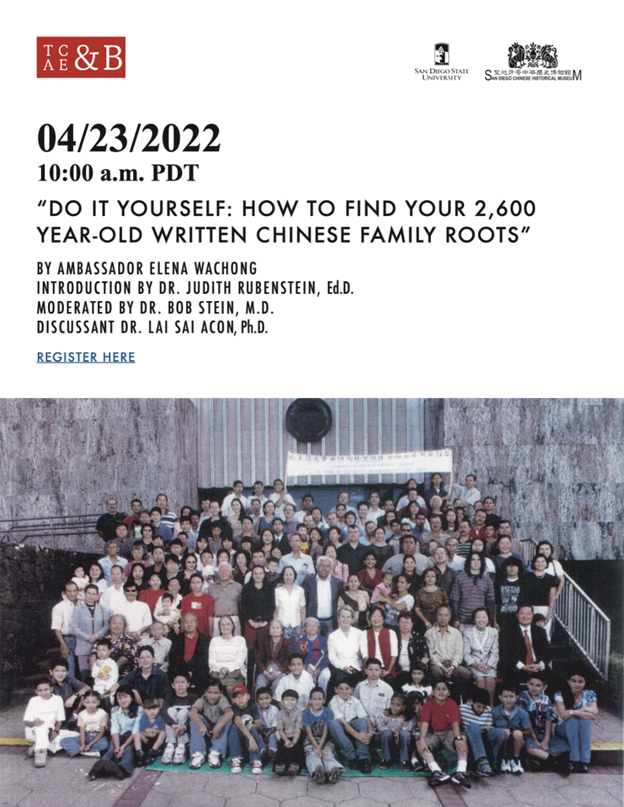
Speaker :
Tiffany Chin
Tiffany Chin will join us at the start of Asian Heritage month, for a lecture co-sponsored by the Chinese-American Heritage Foundation and the Chinese American Museum of Chicago.

Speaker :
Russell Low
On January 23, 1943, a B-24 Liberator bomber and its crew of ten men disappeared without a trace in New Guinea. Their families never knew what happened to them. Now, 80 years later, their long-forgotten letters and dusty photographs finally tell their story in Dr. Low’s new book.
Join us on June 18, as the author shares the story of Stanley Low, a Chinese American kid from Salem, Oregon, who wasn’t yet old enough to vote or drink beer, yet, who joined the army because there was a war on and it was his duty. As Stanley trained to become a bomber nose gunner and went into combat, he experienced loneliness, racism, his first beer, his first romance, and the horrors of war.

Speaker :
Allie Arnell
Most of us are aware that Dragons and Phoenix were important symbols in the culture
of China. But Chinese art was filled with important symbols that would have had and
often still have deep meaning for the people of China. We will explore the varied
expressions of the dragon, the phoenix and other symbols in many types of art from
China. Additionally, we will contemplate their meaning in different moments of the
long history of China.

Speaker:
LILLY CHENG
The 6th lecture in the China³ series will consider traces of the maritime silk road, through the exploration of seacraft remains on the ocean floor at latitudes spanning from the South China Sea to the Norwegian Trench. What stories might these shipwrecks hold, as time capsules of the maritime silk road? How do the remains evidence global commerce, along with the interconnectivity of arts and cultures? What ethical implications come into effect with the contemporary salvage and sale of cargo from seacraft manned by a variety of historical actors, from merchants to pirates to colonists?
Speaker :
Dr. William Ma
On October 15th, Dr. William H. Ma (Assistant Art History Professor at Louisiana State University) will give a presentation on his research, considering the appearance of European figures as decorative motifs in architecture and quotidian objects produced in Guangdong, China, during the 18th and 19th centuries. He will be joined by Patricia J. Yu, a doctoral candidate at UC Berkeley studying the Qing imperial garden of the Yuanmingyuan, as discussant.

On February 6, 1885, the city of Eureka, CA in Humboldt County expelled approximately 300 Chinese immigrants following the accidental shooting of a local councilmember. This major event, which influenced many copy-cat events throughout Humboldt County and the West in the years to follow, continues to shape the demographic reality and lived experience of Asian-American individuals in the region over 130 years later. This presentation will discuss the context of the expulsion, resistance by the immigrant community, and current work to recognize this historical legacy today.
Speaker
Katie Buesch

Here is youtube “The Story of Lim Lip Hong (1840/43-1920): Railroad Contractor, Mine
Owner, Rancher, Butcher, and Venture Capitalist”
link.
BY SUE FAWN CHUNG
MODERATOR BOB STEIN
For more information, please contact the CCC at 619-594-4791 or by emailing : [email protected]
